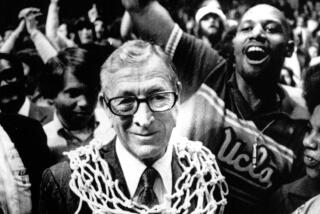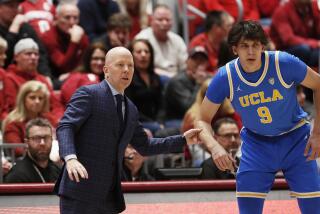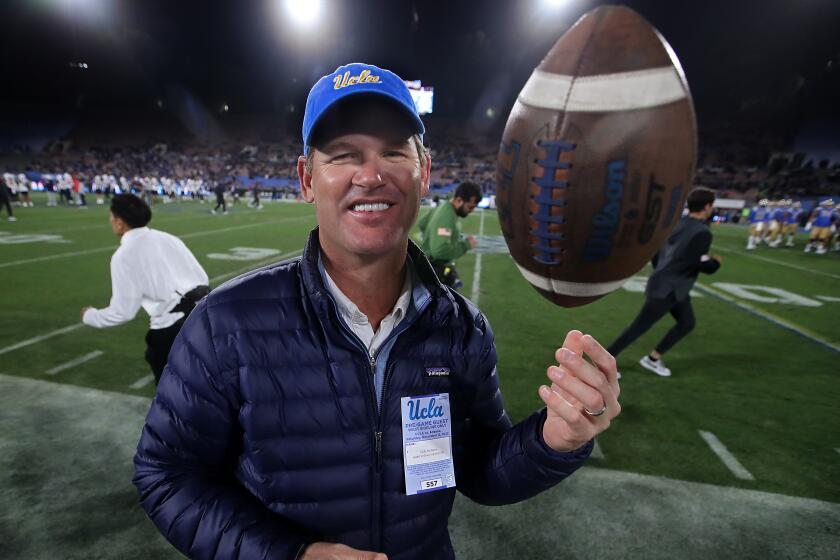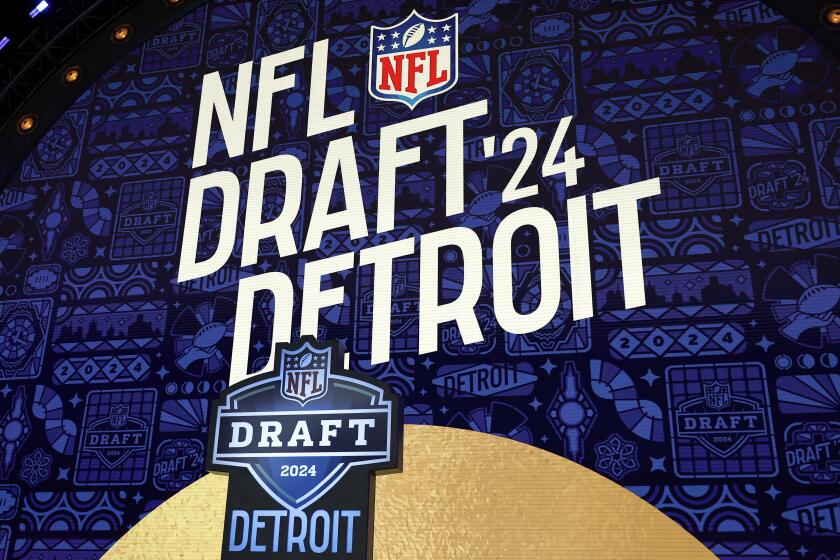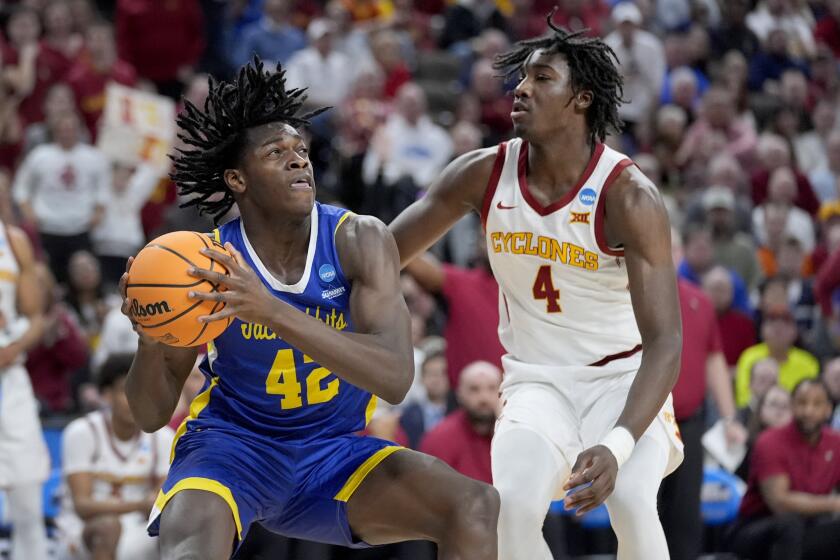College basketball ahead: Will UCLA make NCAA tournament?
Last season’s national championship game was a clash of opposite forces in the world of college men’s basketball. It was the old — Connecticut, led by senior Shabazz Napier — versus young — Kentucky’s surging cache of first- and second-year stars.
The game underscored the difficult line programs must now tiptoe. Often, the best players are gone after a year, so the powers seek to stockpile transient freshman talents. That has led to truly dominant teams (see: Kentucky from last March to date). But it has also taken teams to the brink of collapse (see: Kentucky last season before March).
Kentucky so far this season has merged a supply of remaining talent with yet another wave of freshman stars. Can the Wildcats be beaten?
For a time during a lopsided loss in a nationally televised game earlier this month, UCLA was wondering if they could be scored on.
UCLA has struggled against top competition in the wake of losing three players who became first-round picks in the NBA draft. Meantime, USC, after opening with a loss to Portland State, has come around somewhat and will open Pac-12 Conference play later this week with a winning record.
Whether the Bruins or the Trojans can earn a place in the NCAA tournament remains to be seen — hopes are higher in Westwood than they are near downtown — while league favorite Arizona is hoping for a deep postseason run.
The Final Four and national title game will be played at Lucas Oil Stadium in Indianapolis, but before that the tournament’s West Regional will be held at Staples Center.
In women’s basketball, Connecticut has already taken a loss, so we know anything can happen.
Some questions and answers looking forward to 2015:
Is the UCLA men’s team NCAA-tournament quality?
The Bruins lost to every ranked team they have played this season. They also have defeated every unranked team they have played.
Despite no big win on its resume, UCLA will be under added pressure during the Pac-12 Conference season.
The league has sent an average of about four teams to the NCAA tournament since 2009, and the conference seems stronger this season than it has been in recent years, so a top-four finish should bring an invitation to the tournament. Last season, the Pac-12 sent six teams.
The Bruins still have chances for signature wins.
Can USC climb out of the Pac-12 basement?
The Trojans have competition for last place this season. In the preseason Pac-12 media poll, USC was picked to finish 10th, in front of Washington State and Oregon State.
In USC Coach Andy Enfield’s second season, the Trojans already have shown improvement, with freshman point guard Jordan McLaughlin leading the team in scoring and assists.
Can the Pac-12 ever get back to the Final Four?
Of course. But this season? The conference hasn’t sent a team to the national semifinals since 2008, when Ben Howland guided UCLA there. The drought is now going on year seven, during which time the Horizon League has had two appearances and the Colonial Athletic Assn. and the Missouri Valley Conference each has had one.
Arizona missed out on last season’s Final Four with a one-point, overtime loss to Wisconsin. The Wildcats then lost Aaron Gordon to the NBA, but with freshman Stanley Johnson and a deep, experienced team, they might be better this season.
And this season the conference could have another Final Four contender: Utah, which has defeated Wichita State and lost by three points at Kansas on a bad shooting night.
Which team might make an NCAA tournament Cinderella?
Harvard has been on the cusp of a deep NCAA tournament run for three seasons now. Coach Tommy Amaker’s team defeated Cincinnati last season and narrowly lost to Michigan State. In 2013, the Crimson defeated New Mexico before running into Arizona.
This season, Harvard might be even better. Guards Wesley Saunders and Siyani Chambers are top-flight talents and the Crimson plays great defense.
Will anyone beat Kentucky?
History says … probably. No team since Indiana in 1976 has been perfect through the regular season and postseason.
But Kentucky has flexed its muscles with a 32-point win over Kansas, a 39-point win over UCLA and victories over North Carolina by 14 and Texas by 12. The Wildcats lost Alex Poythress for the season because of a knee injury, but their stable of McDonald’s All-Americans hasn’t skipped a beat.
Basketball statistician Ken Pomeroy puts the Wildcats’ chances at remaining unbeaten in the regular season at round 10%, but when Kentucky plays to its potential nobody in the country can match its talent.
Is the era of one-and-done players hurting college basketball?
Last season during the NCAA tournament, comedian Jimmy Kimmel stopped people on the streets of Los Angeles and asked if they could name a college basketball player. Only one person could — he named Julius Randle, then a freshman at Kentucky.
Within months, Randle was gone, drafted by the Lakers.
In the era of one-and-done players, it’s difficult to figure out who’s playing where each season, but whether that is hurting the game depends on whom you ask.
If fans are connecting less with individual players, that hasn’t stopped them from watching. Viewership of NCAA tournament games in 2014 was the highest since 1993, according to Nielsen.
What if anything can be done about all the television breaks?
It happens often. The score is close late in a game and there are fouls to stop the clock, timeouts to script plays and replays to review.
Instead of basketball, television viewers get commercials.
Fixing late-game delays requires a fundamental change in basketball rules and television contracts, but in 2015 the NCAA is taking a few cautious first steps toward speeding up games.
During the NIT postseason tournament, the NCAA will experiment with a rule to limit commercial breaks. When a team calls a timeout within 30 seconds before media timeouts — which occur every four minutes — that break will become the media timeout.
It’s a small measure that won’t affect the end of games, but if it becomes permanent next season it shows that the NCAA is starting to take action.
More to Read
Go beyond the scoreboard
Get the latest on L.A.'s teams in the daily Sports Report newsletter.
You may occasionally receive promotional content from the Los Angeles Times.
